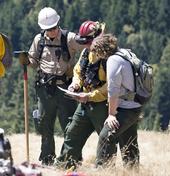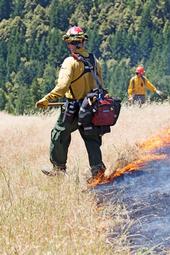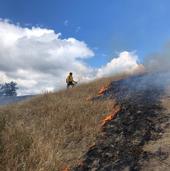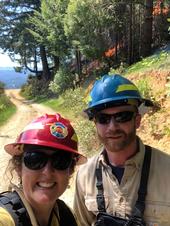
UC ANR among sponsors of 10th International Fire Ecology and Management Congress
Scientists, land managers, educators and students from a variety of organizations worldwide will gather from Dec. 4-8 in Monterey, California for the 10th International Fire Ecology and Management Congress. The conference is hosted by the Association for Fire Ecology in cooperation with the California Fire Science Consortium.
Major sponsors include University of California Agriculture and Natural Resources, with the Esselen Tribe of Monterey County as the host tribe. There are more than 25 additional...
- Author: Kat Kerlin, UC Davis

Study highlights 4 strategies to overcome barriers to prescribed fire in the West
Prescribed fire, which mimics natural fire regimes, can help improve forest health and reduce the likelihood of catastrophic wildfire. But this management tool is underused in the fire-prone U.S. West and Baja California, Mexico, due to several barriers.
A paper from the University of California, Davis, pinpoints those obstacles and suggests four key strategies that policymakers and land managers can take to get more “good fire” on the ground in North America's fire-adapted ecosystems. The paper also provides...
- Author: Pamela Kan-Rice

New certification program will increase opportunities for prescribed fire across California
A group of 19 experienced prescribed burners are gathered in Eureka this week to become certified as prescribed fire burn bosses. The group is the first cohort to participate in the California State-Certified Burn Boss course, part of a certification program that was mandated by legislation in 2018, but was only recently finalized and approved. The course, hosted in Eureka by University of California Cooperative Extension, is a full week session and includes topics from laws, regulations, and permits to burn planning and smoke management.
"With each catastrophic...
- Author: David Liebler, Director of Public Affairs & Member Services, California State Association of Counties

On a crisp and clear morning late last year, around 20 volunteer firefighters, landowners and community members gathered on a plot of land outside of the small rural community of Kneeland in Humboldt County. They listened intently to detailed instructions on how to safely burn 20 acres of private property that gradually rises on a hill before them. The volunteers gathered to learn how to successfully undertake a prescribed burn. It was all part of the ongoing education and training being conducted by Humboldt County's Prescribed Burn Association – the first of its kind west of the Rockies.
Lenya Quinn-Davidson and Jeffery Stackhouse, who both work for the UC...
- Author: Jeannette E. Warnert

California's 2018 wildfire season was the deadliest and most destructive the state has ever seen. Even before the flames were extinguished, politicians, researchers, foresters, firefighters, insurance and utility company representatives, homeowners and landowners in the state's wildfire-prone areas were trying desperately to figure out how such devastation could be prevented in the future.
One reason for the destructive fires is a 100-year history in California of aggressive fire suppression. Most of the state's natural ecosystems evolved over millennia with periodic fires. Without fire, natural areas build up a great deal of vegetation – trees, shrubs, leaf litter and pine needles – that once ignited, can fuel a...



